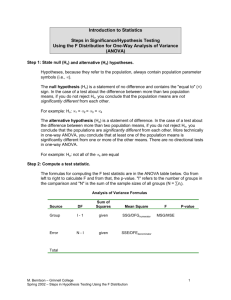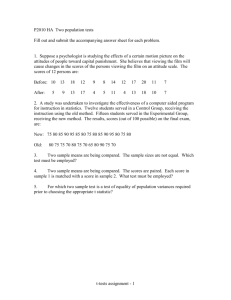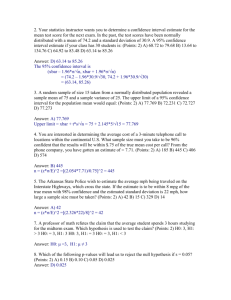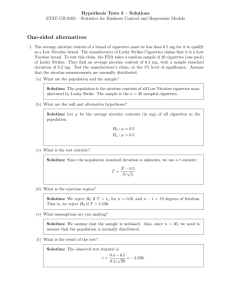Steps In Significance/ hypothesis Testing Using
advertisement
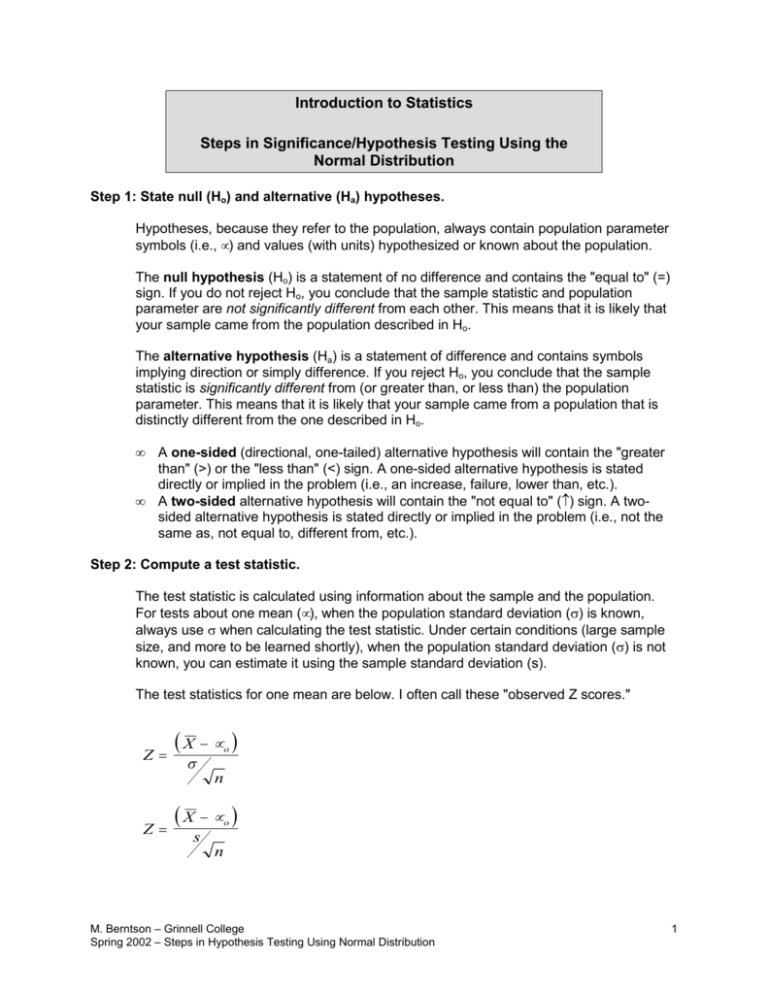
Introduction to Statistics Steps in Significance/Hypothesis Testing Using the Normal Distribution Step 1: State null (Ho) and alternative (Ha) hypotheses. Hypotheses, because they refer to the population, always contain population parameter symbols (i.e., µ) and values (with units) hypothesized or known about the population. The null hypothesis (Ho) is a statement of no difference and contains the "equal to" (=) sign. If you do not reject Ho, you conclude that the sample statistic and population parameter are not significantly different from each other. This means that it is likely that your sample came from the population described in Ho. The alternative hypothesis (Ha) is a statement of difference and contains symbols implying direction or simply difference. If you reject Ho, you conclude that the sample statistic is significantly different from (or greater than, or less than) the population parameter. This means that it is likely that your sample came from a population that is distinctly different from the one described in Ho. • • A one-sided (directional, one-tailed) alternative hypothesis will contain the "greater than" (>) or the "less than" (<) sign. A one-sided alternative hypothesis is stated directly or implied in the problem (i.e., an increase, failure, lower than, etc.). A two-sided alternative hypothesis will contain the "not equal to" (≠) sign. A twosided alternative hypothesis is stated directly or implied in the problem (i.e., not the same as, not equal to, different from, etc.). Step 2: Compute a test statistic. The test statistic is calculated using information about the sample and the population. For tests about one mean (µ), when the population standard deviation (σ) is known, always use σ when calculating the test statistic. Under certain conditions (large sample size, and more to be learned shortly), when the population standard deviation (σ) is not known, you can estimate it using the sample standard deviation (s). The test statistics for one mean are below. I often call these "observed Z scores." Z= Z= (X − µ ) σ o n (X − µ ) o s n M. Berntson – Grinnell College Spring 2002 – Steps in Hypothesis Testing Using Normal Distribution 1 Step 3: Make a decision about the null hypothesis (Ho). In this step, you will either reject or not reject Ho. When you reject Ho, you conclude in favor of the alternative hypothesis (Ha) of significant difference. When you do not reject Ho, you conclude in favor of the null hypothesis of no significant difference. There are two decision rules you may follow. You should know how to use each one. Decision Rule 1 instructions: Find a p-value and compare it to your significance level (α). P-values are the probabilities associated with the test statistic (observed Z) found in step 2. Use Moore's Table A and the instructions below to find the p-value. How to Find P-Values Using the Normal Distribution Table Test Statistic (observed Z) negative number P-value for one-sided tests probability in Table A P-value for two-sided tests 2 x (probability in Table A) positive number 1.0 - probability in Table A 2 x (1.0 - probability in Table A) Decision rule 1: If p-value < α, reject Ho. If p-value > α, do not reject Ho. Decision Rule 2 instructions: Find a critical value (Z*) and compare it to your test statistic. Critical values (Z*) are the Z scores associated with your level of significance (α). Use the table of critical values below. Table of Critical Values (Z*) Significance Level (α α) .10 Z* 1 for one-sided tests 1.282 Z* for two-sided tests .05 1.645 ± 1.96 .01 2.326 ± 2.576 .001 3.091 ± 3.291 ± 1.645 Decision rule 2: If test statistic > Z*, reject Ho. If test statistic < Z*, do not reject Ho. 1 For one-sided hypotheses: If Ha has a "greater than" (>) sign, Z* is a positive number. If Ha has a "less than" (<) sign, Z* is negative. M. Berntson – Grinnell College Spring 2002 – Steps in Hypothesis Testing Using Normal Distribution 2



